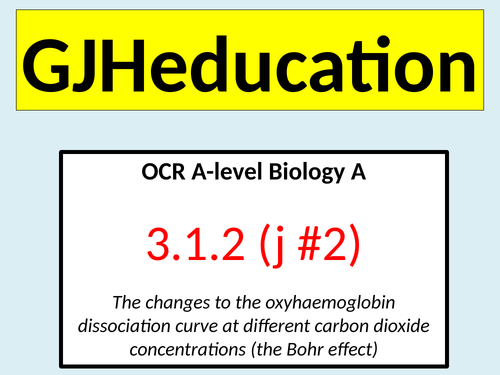



This fully-resources lesson looks at the phenomenon known as the Bohr effect and describes and explains how an increased carbon dioxide concentration affects the dissociation of oxyhaemoglobin. The PowerPoint has been designed to cover the second part of point 3.1.2 (j) of the OCR A-level Biology A specification and continually ties in with the previous lesson on the role of haemoglobin.
The lesson begins with a terminology check to ensure that the students can use the terms affinity, oxyhaemoglobin and dissociation. In line with this, they are challenged to draw the oxyhaemoglobin dissociation curve and are reminded that this shows how oxygen associates with haemoglobin but how it dissociates at low partial pressures. Moving forwards, a quick quiz is used to introduce Christian Bohr and the students are given some initial details of his described effect. This leads into a series of discussions where the outcome is the understanding that an increased concentration of carbon dioxide decreases the affinity of haemoglobin for oxygen. The students will learn that this reduction in affinity is a result of a decrease in the pH of the cell cytoplasm which alters the tertiary structure of the haemoglobin. Opportunities are taken at this point to challenge students on their prior knowledge of protein structures as well as the bonds in the tertiary structure. The lesson finishes with a series of questions where the understanding and application skills are tested as students have to explain the benefit of the Bohr effect for an exercising individual. These questions are differentiated to allow students of differing abilities to access the work and to be challenged
Get this resource as part of a bundle and save up to 44%
A bundle is a package of resources grouped together to teach a particular topic, or a series of lessons, in one place.
Module 3: Exchange and transport (OCR A-level Biology A)
This bundle contains 18 detailed and engaging lessons which cover the following specification points in module 3 (Exchange and transport) of the OCR A-level Biology A specification: 3.1.1: Exchange surfaces * The need for specialised exchange surfaces * The features of an efficient exchange surface * The structures and functions of the components of the mammalian gaseous exchange system * The mechanism of ventilation in mammals * The mechanisms of ventilation and gas exchange in bony fish and insects 3.1.2: Transport in animals * The double, closed circulatory system in mammals * The structure and functions of arteries, arterioles, capillaries, venules and veins * The formation of tissue fluid from plasma * The external and internal structure of the heart * The cardiac cycle * How heart action is initiated and coordinated * The use and interpretation of ECG traces * The role of haemoglobin in transporting oxygen and carbon dioxide * The oxygen dissociation curve for foetal and adult haemoglobin 3.1.3: Transport in plants * The structure and function of the vascular systems in the roots, stems and leaves * The transport of water into the plant, through the plant and to the air surrounding the leaves * The mechanism of translocation As well as the detailed A-level Biology content of the PowerPoint slides, the resources contain a wide range of tasks including guided discussion points, exam-style questions and quiz competitions which will engage and motivate the students
Module 3.1.2: Transport in animals (OCR A-level Biology)
Each of the 9 lessons in this bundle are fully-resourced and have been designed to cover the content as detailed in module 3.1.2 (Transport in animals) of the OCR A-Level Biology A specification. The specification points that are covered within these lessons include: * A double, closed circulatory system * The structure and function of arteries, arterioles, capillaries, venules and veins * The formation of tissue fluid from plasma * The internal and external structure of the mammalian heart * The cardiac cycle * How heart action is initiated and coordinated * The use and interpretation of ECGs * The role of haemoglobin in transporting oxygen and carbon dioxide * The dissociation curve for foetal and adult haemoglobin * The Bohr effect The lessons have been written to include a wide range of activities and numerous understanding and prior knowledge checks so students can assess their progress against the current topic as well as be challenged to make links to other topics within this topic and earlier topics If you would like to see the quality of the lessons, download the formation of tissue fluid. heart action and ECGs lessons as these are free
Something went wrong, please try again later.
This resource hasn't been reviewed yet
To ensure quality for our reviews, only customers who have purchased this resource can review it
Report this resourceto let us know if it violates our terms and conditions.
Our customer service team will review your report and will be in touch.